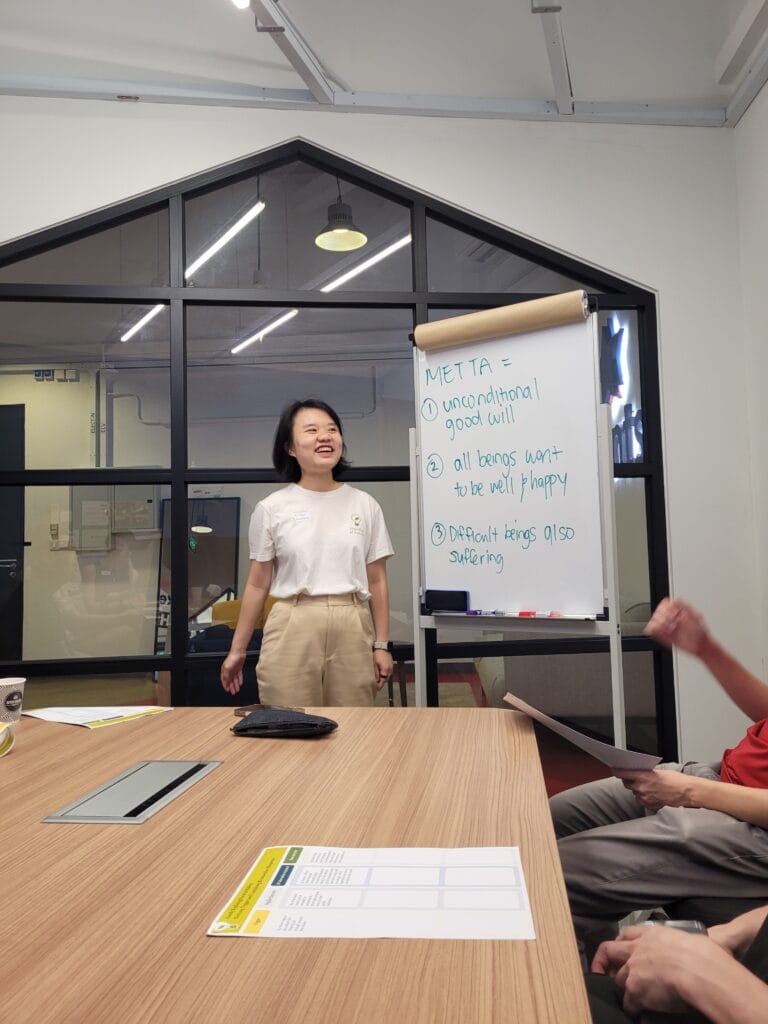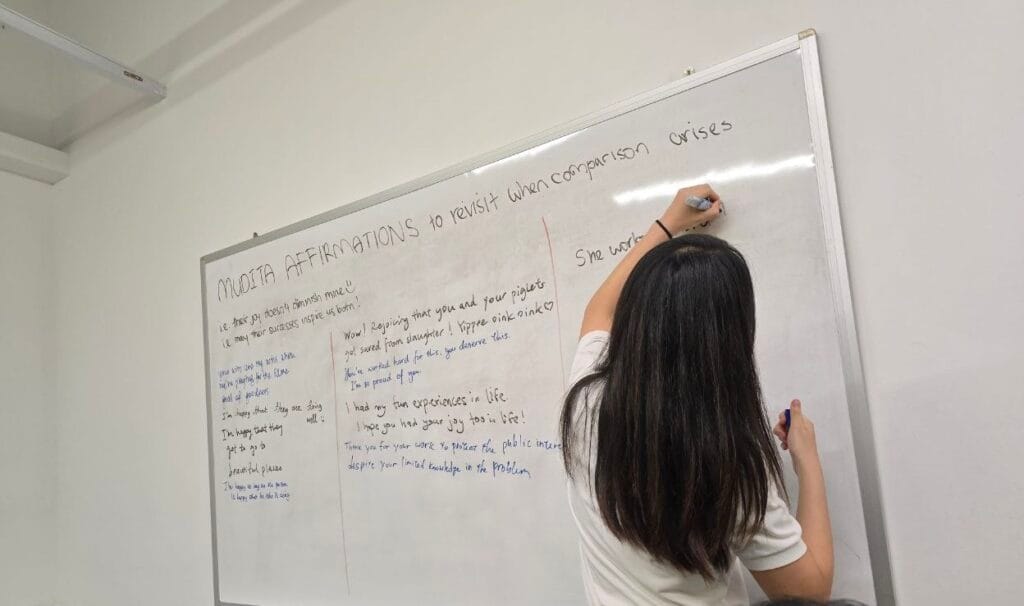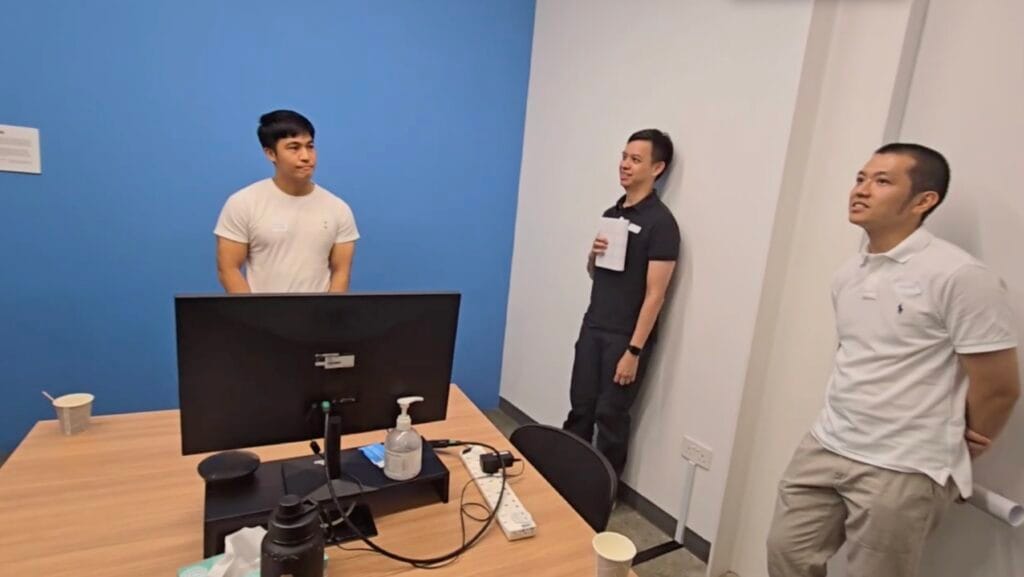TLDR: By practising the Brahmaviharas, we can transform emotional struggles into moments of connection, wisdom, and peace.
On HOL’s community day, our attendees had a chance to join four different rooms with four different Brahmavihara activities. Our team each facilitated one of the rooms and helped to bring the practice to life through different activities.
This is our individual reflection of our community day. May this benefit you in the practice and move towards internalising the four Brahmaviharas in daily life.
Metta – You Shan

In the Room of Metta, we explored what it means to hold ourselves and others with warmth, especially those we find hard to love. One of the most powerful exercises of the day invited us to write a letter to someone we found difficult, and then share our reflections with a partner.
What struck many of us was how, despite the uniqueness of our stories, the roots of our struggles were surprisingly alike.
One participant reflected, “The people we find difficult often provoke us in similar ways. Beneath the surface, we’re all clinging to ego, holding onto views, and acting out of ignorance.” That insight was humbling: none of us are particularly unique in our suffering. We are all beings, driven by the same longing to be seen, to be understood, and to be at peace.
Another reflected, “While writing to a difficult person, I noticed I was at ease. I could sincerely wish them well because I had already practised forgiveness and gratitude towards them. With patience and diligence, we really can cultivate metta over time and find freedom from resentment.”
We were reminded that metta doesn’t mean ignoring others’ faults or denying our hurt. Rather, it’s a willingness to see others as conditioned beings just like us. When we truly see this, metta arises naturally, even in moments of conflict.
One participant took a different route: “I chose to write to my future self. It reminded me that sending metta inward is just as important. The exercise helped me recollect my aspirations and reconnect with what I hope my future self will feel, which is peace, clarity, and courage.”
One participant summed it up beautifully: “Even where bridges seem burnt, there’s still the possibility of warmth, understanding, and peace.
Karuna – Cheryl

Many people came to the Room of Compassion having been inspired by the Goddess of Compassion, Kuan Yin herself.
Yet, many arrive without truly understanding how to be compassionate to themselves and for others. In this space, we witnessed something beautiful: how our bodies respond differently in moments of pressure versus calm, in anxiety versus peace and joy.
One woman shared, “When I’m overwhelmed, my breath is shorter and I feel tighter in my chest area. But here, I noticed my chest relax and the breath deepens” Maybe this is what compassion feels like.
That simple inner shift reminded us of the practice. The opportunity for practice begins in the body when we choose softness over survival.
It’s not out there, it starts right here. And it is up to us to find that opportunity to reset.
Mudita – Kaylee

We began with a simple but powerful activity: spending a few mindful minutes on a social media platform that often stirs emotions. It could be Instagram, LinkedIn, or wherever the scroll hits hardest.
But instead of reacting automatically, we paused to observe. What stories were arising in the mind? What feelings were being triggered?
Then, together, we responded with mudita affirmations, joy in the joy of others, as a skillful way to meet those moments. Mudita is joy that doesn’t arise because we benefit and doesn’t diminish when someone else succeeds more than us.
One participant shared how posts about fitness achievements may spark feelings of inadequacy. The turning point? Recalling their reason for starting a fitness journey which is not to be better than others, but for health and freedom from pain. Grounding back into that intention dissolved the self-judgment.
Another member noticed how clickbait headlines and tragic news stories often hijack our attention and stir up negativity. When we don’t have the inner capacity to hold these emotions skillfully, one wise option is to simply adjust content preferences—to gently say, “not right now,” and see less of these posts.
But when we do have the capacity, these same posts can become a powerful opportunity to practice. Instead of reacting, we can pause, breathe, and send metta to those affected. What once triggered distress becomes a moment to open the heart.
Someone else spoke about LinkedIn envy, how seeing peers’ achievements could trigger a sense of falling behind. But instead of getting caught up in comparing end results, they began shifting focus to the process behind the success.
They reflected on the unseen effort, challenges, and persistence it must have taken, and rejoiced in that journey. Hopefully, this shift in perspective can become a wellspring of encouragement to keep going when the going gets hard.
Another poignant insight: envy doesn’t hurt the other person, it only robs us of joy. Mudita offers a way out. It’s a reminder that joy isn’t a zero-sum game. Neither is it scarce nor finite. When we truly celebrate others, we create new joy from existing joy. Practicing mudita protects the heart & mind from ill-will, bitterness, resentment, and burnout. It fosters resilience and emotional balance.
Upekkha – Heng Xuan

Ever felt like life is a non-stop rollercoaster of emotions? One moment you’re celebrating a big win, the next you’re stuck in a traffic jam after a long day. In this breakout, we explored how Upekkhā (equanimity) can help us stay grounded no matter what’s happening around us. I joked that equanimity is not a helpful translation as we do not use that word on a daily basis and provided participants analogies to think about it.
Upekkhā doesn’t mean being cold or indifferent. It’s the kind of inner calm that allows you to face joy and sorrow, success and failure, with the same steady heart. We shared an analogy on Uppekha.
Imagine a ship captain steering through a violent storm. The captain is fully alert, attentive to every wave and gust, making wise decisions to keep the crew safe. He is not panicked by the storm nor overjoyed by calm seas; he remains steady, caring for the ship and everyone on board, regardless of the circumstances. His calm comes from wisdom and responsibility, not from ignoring the situation.
Indifference is the equivalent of a bystander on land, being indifferent to whatever happens to the ship. Even if it sinks, they are not frazzled by it.
Staying still, even when life gets loud.
We invited participants to reflect on a situation where they felt they had reacted unskillfully to a negative stimulus (e.g., a difficult relationship, a mistake at work, or uncertainty about the future). Then we asked: What would change if you responded with steadiness instead of stress?
In pairs, they shared the incident with one another and how they would have reacted to it differently if they had equanimity. Their partner would then share back on how they would also react differently if in a similar situation.
Equanimity isn’t about suppressing emotions, but about creating space to respond wisely.
Next time you’re caught in a whirlwind of stress or emotion, pause and ask:
Can I hold this with calm?
That small moment of awareness might be the beginning of your journey towards Upekkhā.
Wrapping the four together

We had so much fun learning and sharing with one another at our different rooms. We were glad that everyone came in to candidly learn and share.
Instead of reinforcing unhelpful patterns, we can choose to take up residence in these inner sanctuaries metta, karuna, mudita, and upekkha like settling into a spacious, welcoming home for the heart.
A place where peace and joy live, and where our responses can nourish rather than harm.
Wise Steps
- Practice Metta (Loving-kindness) towards yourself and others: Start by cultivating warmth and understanding for both the people you find easy to love and those you find difficult. Reflect on shared human experiences to dissolve resentment and open your heart to compassion.
- Cultivate Karuna (Compassion) through physical awareness: Tune into your body’s response in moments of stress. Choose softness over survival when you feel overwhelmed, and take a moment to reset by focusing on your breath and body.
- Embrace Mudita (Joy without Comparison): Shift your focus from envy or self-judgment when encountering others’ successes. Celebrate the joy of others without diminishing your own, and find joy in the journey rather than the destination.
- Practice Upekkha (Equanimity) in challenging situations: Respond to life’s ups and downs with steady mindfulness. Rather than reacting impulsively, create space to respond wisely, even in moments of stress, knowing that equanimity allows you to maintain balance and clarity.


